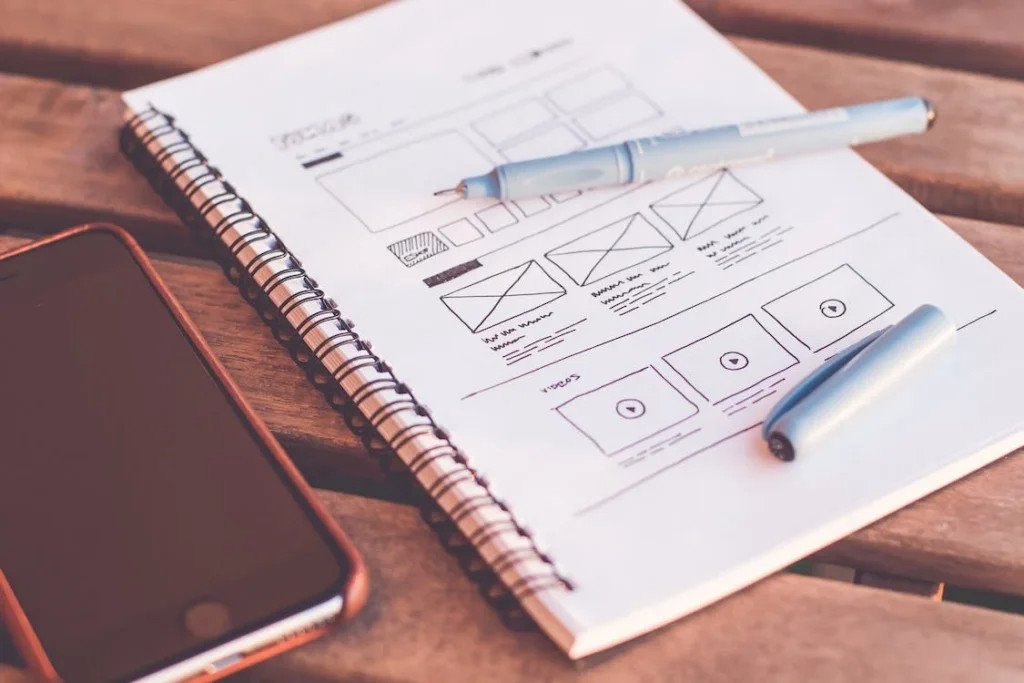When creating a website, we must consider many things to ensure that our website design turns out to be a hit. Creating a friendly homepage provides our users with a comfortable environment and helps them explore your website. That’s why creating a suitable homepage for your website is essential. In this blog, we will tell you How to Design a Homepage and the best tips to follow in enhancing the UX of your homepage.
What Is a Home Page Design?

Every website has a homepage. It is the main landing page of the website. The home page is the first Web page that appears after you launch a Web browser. From the homepage, users can go to different sections of the website. It is the page that serves as the website’s point of entry. The layout, colors, design, shapes, etc of a homepage is called a homepage design.
A homepage design is not all about aesthetics. It’s more about the simplicity and ease with which users can navigate information and other pages of your websites through the homepage. That is why it is essential to understand which elements your audience desires on your homepage.
Why Is It Essential to Create a Good Homepage Design?
Creating a good homepage design provides users with a comfortable environment where they can easily navigate the website. This is why creating a good homepage design is very important if you want your website to succeed. A good homepage design ensures a good user experience and creates an excellent first impression on potential customers. Too much information on the screen looks cluttered, and viewers may become frustrated and leave the website since it is too stressful and overwhelming.

7 Easy Steps to Design and Build a Homepage
Now let’s cover the critical point “how to design a homepage?”. We have created a set of simple steps to follow while designing a good homepage.
- Gather Market and Customer Insights
- Select a Layout
- Choose a Platform to Design
- Hire a Designer
- Add Content
- Add an Appropriate Call to Action
- Launch
1) Gather Market and Customer Insights
Customer insights provide feedback on how your website is doing on the web, enabling you to identify any problems and fix them before they damage your website’s reputation. These insights can also assist you in understanding how to raise service standards and enhance the entire user experience (UX). Therefore, before diving into the designing process, look for customer feedback and analyze which elements will highly attract them.

For example, if you are a clothing apparel website, your top-selling products should be on the homepage with catchy captions. And menu option should be visible so that users can navigate through a broad category of products.
2) Select a Layout
A variety of elements, including consistency, colors, font, images, simplicity, and usefulness of the layout, drive a good homepage design. How a website is seen depends on several important design considerations. A creative website homepage design can encourage users to take action by fostering trust. For this reason, you should select a simple layout. Keep all of your most crucial text and images above the fold, where users can see them.
3) Choose a Platform to Design
Choosing the right platform to design your website is very important for people who don’t want to hire a professional to design their website for them. There are many website designing platforms in the market, but some famous and good ones are Wix, WordPress.org, Weebly, and many more.
4) Hire a Designer
For designing a homepage, you can hire freelancers from Upwork or Fiverr and pay them to design your website. Outsourcing the design process can reduce costs, but you might lose the chance to participate in the process actively. A website designer is usually a professional at designing websites, so paying a designer to design a homepage is helpful. So the other way you can do this is by hiring an agency of professional web designers, graphic designers, or digital designers.

5) Add Content
After designing a layout for your homepage, it’s time to start adding content. Page content can be displayed as text, links, photos, music, animation, or videos. Search engines can only recognize a certain amount of music, video, animation, and graphics. You should optimize your content for SEO so that search engines can easily crawl through your website. You would also want to optimize your website’s standing on a search engine; therefore, try to add relevant and organic content.
6) Add an Appropriate Call to Action
A call to action (CTA) is a suggestion for the user to perform a specific action on a website. A compelling CTA may assist with decision fatigue and give your content significance. “Sign Up Now” or “Buy Now” are typical examples of CTA.
7) Launch
After you have completed all the steps written above, it’s time to finally launch your website for people to explore and give feedback. At the initial stages of launching the website, it’s best to stay abreast of the customer’s perception building for your website and tweaking content according to their liking.
12 Best Tips to Consider While Designing Your Homepage
Now that we know how to design a homepage in simple and easy steps, let’s learn the best tips to help you improve your homepage’s UI. Here we have a list of the best tips that you should follow:
- Manage Combination of Color Scheme & Background
- Keep A Clean and Easy to Navigate Layout
- Buttons Optimization
- Use High-Resolution Images
- High-quality and Updated Content
- Engaging Experience for User
- Responsive Design
- Add Live Chat Support
- Simplify the Design
- Test Your Design on Multiple Devices
- Build an Effective Team
- Use of Animation
1- Manage Combination of Color Scheme & Background
A Creative website home page design requires thinking and time. The Background and the color scheme of a homepage play a key role in attracting users and forcing them to stay longer. Many color schemes include warm and bold colors, sharp and modern colors, etc. You should choose a color scheme that best represents your brand and targets the right emotions of your customers.

2- Keep a Clean and Easy to Navigate Layout
A Clean and arranged layout makes it simple for users to scroll through your website. Put your website’s elements where users expect them to be so they can quickly go to different parts of your website without having to find specific buttons.
3- Buttons Optimization
As we know call to action (CTA) is a suggestion for a user to perform a specific action on a website. Because it grabs attention and requires a brief response from the user, clickable buttons are the most common kind of CTA. You’ll get more out of your page if you learn how to create a powerful CTA button.

4- Use High-Resolution Images
While designing a homepage, you must ensure that every single image used in the process is of high resolution. A low resolution will be choppy and blurry, which will have a very negative effect on users. You will also need to optimize your homepage for responsiveness so that images load faster.

5- High-Quality and Updated Content
The material on your website should be unique, specialized, and of excellent quality. Your content should always be up-to-date with its context so that visiting users don’t think the website is outdated and might not find what they are looking for.
6- Engaging Experience for User
The experience users obtain after using a product thoroughly and for an extended period is an engaging experience. You must optimize your website by designing a proper UX to encourage user engagement. A lot of research goes into optimizing a homepage for quality UX.
Read about: 18 Tools to Measure, Quantify and Optimize the UX
7- Responsive Design
A responsive web design creates websites that look good on every device, either mobile, laptop, PC, or tablet. It is vital for your website and every webpage to have a responsive web design. You will lose many audiences if a homepage doesn’t load quickly on any device or the interface doesn’t go well with different devices. For this reason, designers use a mobile-first approach when designing a website.

8- Add Live Chat Support
When a customer clicks on your website with a transactional purpose, they must be able to see a live chat support option on all the pages. Usually, customers land on the homepage, so a live chatbot or CSR should be there 24/7 to assist customers with their queries. This will increase your customer satisfaction.
9- Simplify the Design
Some brands forget that a good homepage design is simple and unique instead of complicated and stuffed with many features, buttons, etc. Studies have proven that a simple web page design works better for attracting customers than a vibrant one.
10- Test Your Design on Multiple Devices
Cross-device web testing is helpful in checking the responsiveness of a web page design. A website shouldn’t just look great on the device you are using to create it; it should work excellently on every device. To ensure a website’s usability, designers use many tools to test a website on different devices. Use Google Dev Tools, Browser Stack, Sizzy, etc, to test your webpage.
Read here: What Is Website Usability Testing?
11- Build an Effective Team
To understand the response you anticipate from your end customer, it is necessary to build a compelling product design team for your website. The team will be responsible for designing an effective homepage and learning from market trends. A good product design team will also use the best design principles in your homepage design.
Read here: How to Build an Effective Product Design Team
12- Use of Animation
Besides high-resolution images and videos, animations can improve your homepage design game. Animations can help you create professional web page designs, highlight specific elements, increase customer engagement and create a lasting brand image. Using dynamic and smooth animations in your homepage design would be best.
Benefits of a Good Home Page Design
Your landing page must attract users if you want to improve your CTR. Gaining many impressions has no benefits until users are interested in buying your product through your website. Let’s learn what the benefits of a good homepage design are:
- Your website’s aesthetics are as important as it is for an actual store because it makes an excellent first impression on your customers. Therefore, good homepage designs build the first impressions of your website.
- An updated website homepage with no misguiding information builds trust in your customers.
- Web page responsiveness and First Input Delay (FID) help improve your search engine rankings.
- Creative layouts, consistent use of fonts, colors, and button optimization can help you stand out from your competitors.
- An easy-to-navigate homepage is essential for users as it fulfills their purpose of visiting your website.
- Strong branding through your homepage design results in a successful digital marketing campaign.
- Use of modern techniques and the latest trends in designing a homepage increase customers’ interest in your website.

Conclusion
A good homepage design is easier to navigate, has an appropriate CTA, engages users for a more extended period, and is optimized for UX. Experts and professionals in web designing should be hired to provide you with a better homepage design and fulfill your goals. Outsourcing the design process can save you costs, but you cannot be much involved in the development process.
In this blog, you learned how to design a home page and what benefits you can gain from a good and creative homepage design. Nowadays, competition is tough and growing daily; therefore, regularly updating your website pages is necessary. You need to adopt best practices while designing a homepage so that your customers are satisfied and you can build a powerful brand image.
FAQs
What Are Some Excellent Examples of Effective Home Page Design?
A good homepage design contains a Unique Selling Proposition (USP) for its visitors. Some websites that have a really good homepage design are Dropbox, CarMax, Century21, Marc Jacobs, Skype, etc.
Should We Design a Home Page in HTML?
If you are creating a website homepage that doesn’t require regular updates or frequent content addition, then Html is the best choice. Html also helps to make your homepage more responsive and perform faster.
What Does a Homepage in HTML Include?
When you are designing your homepage in HTML, it should be divided into three parts:
1- Header
2- Body
3- Footer
